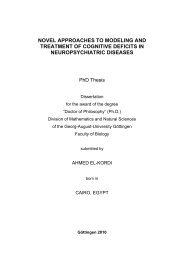Cortical and subcortical mechanisms in persistent stuttering ...
Cortical and subcortical mechanisms in persistent stuttering ...
Cortical and subcortical mechanisms in persistent stuttering ...
You also want an ePaper? Increase the reach of your titles
YUMPU automatically turns print PDFs into web optimized ePapers that Google loves.
Chapter 1 Introduction<br />
<strong>in</strong>dependent of the execut<strong>in</strong>g organs (orofacial /limb) is constra<strong>in</strong>ed <strong>in</strong> the system of persons<br />
who stutter.<br />
Aberrant production-perception-<strong>in</strong>teraction<br />
Current theories of speech production <strong>in</strong>tegrate perceptive processes <strong>and</strong> productionperception-<strong>in</strong>teractions.<br />
Several researchers consider an aberrant sensory feedback system as<br />
potential cause of stutter<strong>in</strong>g. Civier <strong>and</strong> Guenther (2010) dist<strong>in</strong>guish three views:<br />
(1) persons who stutter differ from control subjects by rely<strong>in</strong>g too heavily on sensory<br />
feedback (Tourville et al., 2008; van Lieshout et al., 1993);<br />
(2) persons who stutter benefit from reliance on sensory feedback (Max et al., 2004;<br />
Namasivayam et al., 2008; van Lieshout et al., 1996);<br />
(3) due to an impaired feedforward control system, persons who stutter rely more heavily<br />
on a feedback-based motor control strategy (Civier et al., 2010; De Nil et al., 2001;<br />
Kalveram <strong>and</strong> Jancke, 1989; Zimmermann, 1980b). This suggests that an over-reliance<br />
towards an auditory feedback control strategy <strong>in</strong>creases the systems’ vulnerability to<br />
produce errors. Those errors might cause the motor system to “reset” <strong>and</strong> repeat the<br />
current syllable (Civier et al., 2010). Repetitions would then result from the attempts<br />
to repair large sensorimotor errors as simulated <strong>in</strong> the computer model <strong>and</strong> proven <strong>in</strong><br />
one person who stutters.<br />
1.5 Neurophysiological approaches to expla<strong>in</strong> stutter<strong>in</strong>g<br />
S<strong>in</strong>ce the formulation of the cerebral dom<strong>in</strong>ance theory (Orton, 1928) researchers have<br />
speculated about potential <strong>in</strong>volvement of aberrant neural processes <strong>in</strong> the onset <strong>and</strong><br />
development of stutter<strong>in</strong>g (De Nil, 2004). Early research <strong>in</strong>to the nature of these deviations<br />
was ma<strong>in</strong>ly based on behavioural observations <strong>and</strong> electromyographic measurements. With<br />
advances <strong>in</strong> neuroimag<strong>in</strong>g techniques such as positron emissions tomography (PET) <strong>and</strong><br />
magnetic resonance imag<strong>in</strong>g (MRI) manifold f<strong>in</strong>d<strong>in</strong>gs about the neural differences between<br />
persons who stutter <strong>and</strong> control subjects has been aggregated, motivat<strong>in</strong>g the emergence of<br />
different hypothesis of bra<strong>in</strong> function <strong>in</strong> stutter<strong>in</strong>g. The follow<strong>in</strong>g section targets to <strong>in</strong>troduce<br />
three of these hypotheses lead<strong>in</strong>g to the motivation of the studies presented <strong>in</strong> this<br />
dissertation.<br />
17



